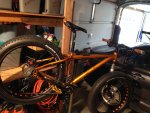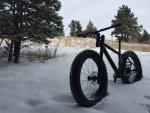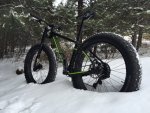You are using an out of date browser. It may not display this or other websites correctly.
You should upgrade or use an alternative browser.
You should upgrade or use an alternative browser.
the new Cannondale Fat CAAD
- Thread starter overland_drifter
- Start date
onebadscrambler
New member
Minimum retail advertised price is 3730. MSRP saves you a little. If your dealer does not have it in stock, there are none available until Feb 26.
Nice fatbike! It's crazy how many manufactures are getting in the game now.
If there is demand, supply will follow. Simple as that. I think that's the reason why 29+ sizes are still a niche. Not enough demand to justify tool-up and production. I personally think that Cannondale is late to the game, not early. As more and more people come to see fatbikes as a great tool in the quiver and not just a one-season oddity, the popularity will continue to grow. I use mine as my only bike. Then again, household economics have as much to do with that decision as my opinion of fatbikes in general.
BTW, I do like the Lefty forks...
 [
[overland_drifter
Observer
I do agree that Cannondale is late to the game but maybe they waited for a reason. I've been on quite a few other brands and this one just seems dialed on the geo. I'm by no means a full on fat biker but when the Dirt is covered, I gotta say, they are super fun. You can always build up and swap in a set of 29+ wheels to go hit the XC trails.
You can always build up and swap in a set of 29+ wheels to go hit the XC trails.
Absolutely. However, technology trickle-down is beginning to put some lightness into many of the components that contributed to the fatbike's portly reputation. Take tires, for instance. My old Surly Nates weighed in at a staggering 1580 grams each, +/-. My current Panaracer Fat B Nimbles (see photo above)...1135 front, 1147 back (weighed both prior to mounting). That's nearly a pound of rotating mass at each wheel. I got them on Amazon for $59/each. The effect it has on handling and responsiveness is galactic, to put it mildly. My point here is that perhaps just a new set of lighter tires may do the trick. Why lay out $500-$1000 for a set of 27.5+s or 29+s if modifications on what you have work?
p nut
butter
I do agree that Cannondale is late to the game but maybe they waited for a reason. I've been on quite a few other brands and this one just seems dialed on the geo. I'm by no means a full on fat biker but when the Dirt is covered, I gotta say, they are super fun. You can always build up and swap in a set of 29+ wheels to go hit the XC trails.
Cannondale makes good bikes. While the Fat CAAD is a cool bike, they still have some work to do on the geo. ie., why such long chainstays? 18"?? Give me short and tight. Give me a nimble wheelbase. Fun in snow, and fun in dirt. Salsa is going the right way with the new Mukluk's.
Absolutely. However, technology trickle-down is beginning to put some lightness into many of the components that contributed to the fatbike's portly reputation. Take tires, for instance. My old Surly Nates weighed in at a staggering 1580 grams each, +/-. My current Panaracer Fat B Nimbles (see photo above)...1135 front, 1147 back (weighed both prior to mounting). That's nearly a pound of rotating mass at each wheel. I got them on Amazon for $59/each. The effect it has on handling and responsiveness is galactic, to put it mildly. My point here is that perhaps just a new set of lighter tires may do the trick. Why lay out $500-$1000 for a set of 27.5+s or 29+s if modifications on what you have work?
Caveat is that the FBN's measure narrower than Nates (I believe). That may have also played a factor in the handling/responsiveness as you're now on a "smaller" wheel. But as you said, tires (and wheels) make a big difference, for sure.
Caveat is that the FBN's measure narrower than Nates (I believe). That may have also played a factor in the handling/responsiveness as you're now on a "smaller" wheel. But as you said, tires (and wheels) make a big difference, for sure.
They certainly do. Almost a half inch each (a touch more than 3.5" once stretched). That was also my intention. I had debated going "+" for some time, and when factoring in economics, the FBN's got me about 75% of the way "there" at a bare fraction of the cost of a new wheelset. When it snows, I'll just pull the FBNs and reinstall the Nates. Or maybe not. Next up is a 1X10 swap from the current 2X10, using a Wolftooth 42 cog in back and a 28t chainring in the front. This should both simplify the drivetrain as well as allow a chainline wide enough to accomodate 5" tires on the Mukluk platform, as there will be no inner chainring. So the Nates may be going the way of the dinosaur. For sale if anyone wants 'em!
deuxdiesel
Observer
I do agree that Cannondale is late to the game but maybe they waited for a reason. I've been on quite a few other brands and this one just seems dialed on the geo. I'm by no means a full on fat biker but when the Dirt is covered, I gotta say, they are super fun. You can always build up and swap in a set of 29+ wheels to go hit the XC trails.
Do you have any feedback on how the Olaf Lefty compares to the RS Bluto (if you ever had a chance to ride one)? I am finishing up my 27.5+ Lefty-equipped Bucksaw, but standard Lefty forks won't handle 4" tires.
cruiserdude80
Observer
What is the benefit to the non-traditional fork/lefty as opposed to the standard fork?
Christophe Noel
Expedition Leader
The lefty fork design is really unique and that goes way beyond the funky aesthetic. Odd as is sounds, it is extremely stiff, torsionally (twisting). That helps immensely with steering accuracy. The internals of the fork are squared. That reduces much of the twisting flex that all manufacturers try to mitigate with heavy crowns and bridges. Also, whereas all forks have two cylindrical components sliding against each other with bushings, the Lefty (squared on the inside) uses four internal planes (sides) of roller pin bearings. Lots of them. 88 as I recall. So, the fluidity of the suspension action is stellar. That eliminates almost 100% of the "sticktion" that effects normal forks. So, a Lefty is stiffer, smoother.What is the benefit to the non-traditional fork/lefty as opposed to the standard fork?
And...they suck for maintenance. They require frequent servicing and are prone to bearing migration which often causes a dreaded top-out "thunk." They've improved over the years, but it's taken a couple decades to get them where they are today.
Last edited:
overland_drifter
Observer
Do you have any feedback on how the Olaf Lefty compares to the RS Bluto (if you ever had a chance to ride one)? I am finishing up my 27.5+ Lefty-equipped Bucksaw, but standard Lefty forks won't handle 4" tires.
Yes, I have ridden both, I think the lefty feels better overall. I'd go rigid before I ran another Bluto, just didn't seem worth the cost to me (and I didn't have to pay for it, haha) Just to clarify, I'm not a full on fat biker. I ride and and race 160mm bikes on the regular so I'm sure there is a lot more opinions from the guys that only pedal fat bikes. Nonetheless, I recommend anyone who like bikes to get out on one, you smile and giggle within the first crank revolution.


